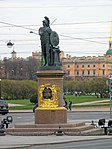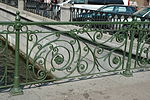Marble Palace
Art museums and galleries in Saint PetersburgCulture in Saint PetersburgGovernment buildings in RussiaHouses completed in 1785Marble buildings ... and 6 more
Modern art museumsNeoclassical architecture in RussiaNeoclassical palacesPalaces in Saint PetersburgRoyal residences in RussiaRussian Museum

Marble Palace (Мраморный дворец) is one of the first Neoclassical palaces in Saint Petersburg, Russia. It is situated between the Field of Mars and Palace Quay, slightly to the east from New Michael Palace.
Excerpt from the Wikipedia article Marble Palace (License: CC BY-SA 3.0, Authors, Images).Marble Palace
Millionnaya Street, Saint Petersburg
Geographical coordinates (GPS) Address Phone number Website External links Nearby Places Show on map
Geographical coordinates (GPS)
| Latitude | Longitude |
|---|---|
| N 59.945176 ° | E 30.326799 ° |
Address
Мраморный дворец
Millionnaya Street 5/1
191186 Saint Petersburg (Palace District)
Saint Petersburg, Russia
Open on Google Maps











